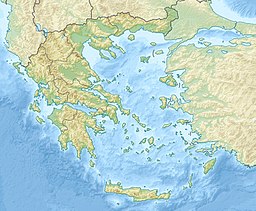| This article needs additional citations for verification. Please help improve this article by adding citations to reliable sources. Unsourced material may be challenged and removed. Find sources: "Saronic Gulf" – news · newspapers · books · scholar · JSTOR (January 2016) (Learn how and when to remove this message) |
| Saronic Gulf | |
|---|---|
| Σαρωνικός κόλπος (Greek) | |
 The Saronic Gulf and its major islands The Saronic Gulf and its major islands | |
 | |
| Location | Attica and the Peloponnese |
| Coordinates | 37°42′N 23°36′E / 37.7°N 23.6°E / 37.7; 23.6 |
| Type | Gulf |
| Part of | Aegean Sea |
| Basin countries | Greece |
The Saronic Gulf (Greek: Σαρωνικός κόλπος, Saronikós kólpos) or Gulf of Aegina in Greece is formed between the peninsulas of Attica and Argolis and forms part of the Aegean Sea. It defines the eastern side of the isthmus of Corinth, being the eastern terminus of the Corinth Canal, which cuts across the isthmus. The Saronic Islands in the gulf have played a pivotal role in the history of Greece, with the largest, Salamis being the location of a significant naval battle in the Greco-Persian wars. The Megara Gulf makes up the northern end of the Saronic Gulf.
The Athens urban area lies on the north coast of the Saronic Gulf.
Etymology
The origin of the gulf's name comes from the mythological king Saron who drowned at the Psifaei lake (modern Psifta). The Saronic Gulf was a string of six entrances to the Underworld, each guarded by a chthonic enemy in the shape of a thief or bandit.
History
The Battle of Salamis, just to the west of modern-day Piraeus, took place in the Saronic Gulf. This naval battle off Salamis Island saw the Athenians defeat Xerxes, assuring Athens its place as the cradle of modern European culture.
The ancient port of Cenchreae used to be situated here.
Geography
The gulf includes the islands of Aegina, Salamis, and Poros along with smaller islands of Patroklos and Fleves. The port of Piraeus, Athens' port, lies on the northeastern edge of the gulf. The site of the former Ellinikon International Airport is also in the northeast.
Beaches line much of the gulf coast from Poros to Epidaurus, Galataki to Kineta and from Megara to Eleusis and from Piraeus down to Anavyssos. Athens' urban area surrounds the northern and the eastern coasts of this gulf.
Bays in the gulf include Phaleron Bay, Elefsina Bay to the north, Kechries Bay in the northwest and Sofiko Bay in the east.
The volcano of Methana is located to the southwest along with Kromyonia at the Isthmus of Corinth, Aegina and Poros. Methana is also the youngest most active volcano center and forms the northwestern end of the cycladic arch of active volcanoes that includes Milos island, Santorini island and Nisyros island. A hydropathic institute at Methana makes use of the hot sulphurous water that still surfaces in the area. The most recent eruption was of a submarine volcano north of Methana in the 17th century.
The gulf has refineries around the northern part of the gulf including east of Corinth and west of Agioi Theodoroi, Eleusis, Aspropyrgos, Skaramangas and Keratsini. These refineries produce most of Greece's refined petroleum products, a large proportion of which are then exported. Commercial shipping to the refineries, Piraeus, and to and from the canal make the gulf quite a busy area with commercial shipping.
Fault lines dominate especially in the northwestern part.

Tributaries
- Kechries Bay
- Saronic Bay Coast (basin)
- Lower Galataki Basin
- Upper Galataki Basin
- Examilia Basin
- Athikia Basin
- Loutro Basin
- Megara Bay/Megara Gulf
- Cephissus River (Eleusis)
- Cephissus (Athenian plain) between Piraeus and Phaliron.
Capes
- Cape Lomvardi - SW of Vouliagmeni
Sailing
| This section does not cite any sources. Please help improve this section by adding citations to reliable sources. Unsourced material may be challenged and removed. (July 2018) (Learn how and when to remove this message) |
Sailing is popular in the Saronic Gulf which, like the neighbouring Argolic Gulf, benefits from the Attic mainland's partial shelter from the summer Meltemi wind that can reach Force 7 and above further to the east in the Aegean islands.
The Gulf boasts two particularly notable archaeological sites: the ancient theatre at Epidaurus and nearby asclepieion and the Temple of Aphaia on Aegina.
Other
The Saronic Gulf is one of congregating areas for short-beaked common dolphins in Aegean Sea. On recent occasions, more of large whales such as fin whales have been sighted in the gulf due to improving environmental conditions.
See also
References
- "The Underworld in Greek Mythology". Greek Legends and Myths. Archived from the original on 2019-06-18. Retrieved 2019-06-18.
- Compared to Hercules and his Labours, "Theseus is occupied only with the sacred Entrances that are local to the lands of Athens" (Ruck and Staples 1994:204).
- "Current knowledge of the cetacean fauna of the Greek Seas" (PDF). 2003. pp. 219–232. Archived (PDF) from the original on 2008-09-07. Retrieved 2016-04-21.
- "A rare Fin Whale visit in the Saronic Gulf". 30 May 2012. Archived from the original on 2016-05-07. Retrieved 2016-04-21.